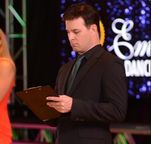
As I get ready to coach with the amazing Jonathan Roberts this week, I thought about some of the things I consider before taking a coaching session and compiled them for you! But before you read on, if you're wondering what a coaching is or looking for the best way to prepare for one, check out our Pro interviews for more information!
I hope these tips help you get the most out of working with some of the great coaches out there, and please feel free to share your own tips in the comments! Until next time, happy coaching and happy dancing!
- Decide what you want to work on ahead of time. Do you want a new routine? Are you struggling with one dance in particular that you need extra help with? Having a specific area of focus can make your session more productive. Discuss with your instructor what you’d like to work on, or if you’re uncertain, ask your instructor what they think would be best.
- Use your coaches to their strengths. If a coach is an accomplished Rhythm dancer, then it might make more sense to work with them on one of your Rhythm or Latin routines. Now that’s not to say they couldn’t help you in another style since usually, coaches are very flexible and able to assist in most situations, but they probably have more experience and in-depth knowledge of the styles they’ve worked in more extensively. If you’re not familiar with the coach that’s visiting, look them up online or ask your instructor.
- Set your expectations accordingly. Know how many sessions you have booked with the coach and talk with you instructor about what you can expect to accomplish in that amount of time. You’re not going to be able to fix all of your problems in a 45-minute session, so decide what’s most important to you and communicate that to your instructor.
- Budget ahead of time. Coaches can be very expensive, so figure out what your budget is and discuss with your instructor how many sessions make sense for you. Many times, just one is enough to choreograph a new basic routine or fix a couple of problem areas. Keep in mind that your instructor also needs to be paid for their time during the coaching, so in addition to the cost of the coach, you’ll also be paying for a lesson.
I hope these tips help you get the most out of working with some of the great coaches out there, and please feel free to share your own tips in the comments! Until next time, happy coaching and happy dancing!




 RSS Feed
RSS Feed